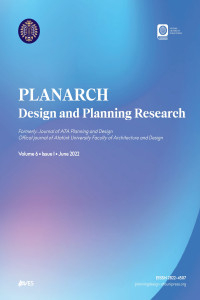Eleştirel Bölgeselcilik Kapsamında Ağa Han Mimarlık Ödülleri’nin Analizi
Ağa Han Mimarlık Ödülleri, bölgeselcilik, eleştirel bölgeselcilik, yerellik, teknoloji
The Analysis of the Aga Khan Awards for Architecture within the Scope of Critical Regionalism
___
- Bader, B. (2021). Islamic cemetery. The Aga Khan Award for Architecture. Erişim adresi https ://th e.akd n/en/ how-w e-wor k/our -agen cies/ aga-k han-t rust- cultu re/ak aa/is lamic -ceme tery. Erişim Tarihi: 26.05.2021.
- Bereuter, A. (2021a). Islamic cemetery. The Aga Khan Award for Architecture. https ://th e.akd n/en/ how-w e-wor k/our -agen cies/ aga-k han-trustcultu re/ak aa/is lamic -ceme tery. Erişim Tarihi: 26.05.2021.
- Bereuter, A. (2021b). Islamic cemetery in Altach/Bernardo Bader Architekten. ArchDaily. https ://th e.akd n/en/ how-w e-wor k/our -agen cies/ aga-k han-t rust- cultu re/ak aa/is lamic -ceme tery. Erişim Tarihi: 26.05.2021.
- Canizaro, V. B. (2007). Introduction. In V. B. Canizaro (ed.). Architectural regionalism: Collected writings on place, identity, modernity, and tradition (pp. 17–33). Princeton Architectural Press.
- Emden, C. (2021a). B2 house. The Aga Khan Award for Architecture. https://th e.akd n/en/ how-w e-wor k/our -agen cies/ aga-k han-t rustcultu re/ak aa/b2 -hous e. Erişim Tarihi: 26.05.2021.
- Emden, C. (2021b). Ipekyol textile factory. The Aga Khan Award for Architecture. https ://th e.akd n/en/ how-w e-wor k/our -agen cies/ agak han-trust- cultu re/ak aa/ip ekyol -text ile-f actor . Erişim Tarihi: 26.05.2021.
- Emden, C. (2021c). Issam Fares Institute for public policy and international affairs. The Aga Khan Award for Architecture. https ://th e.akd n/en/ how-w e-wor k/our -agen cies/ aga-k han-t rust- cultu re/ak aa/is samfares- insti tute- publi c-pol icy-a nd-in terna tiona l-aff airs. Erişim Tarihi: 26.05.2021.
- Emden, C. (2021d). Palestinian museum. The Aga Khan Award for Architecture. https ://th e.akd n/en/ how-w e-wor k/our -agen cies/ aga-k han-t rust- cultu re/ak aa/pa lesti nian- museu m. Erişim Tarihi: 26.05.2021.
- Erdoğdu Erkaslan, Ö. (1999). The Aga Khan awards for architecture and the issue of cultural identity in the Islamic intelligentsia [Doktora Tezi, Dokuz Eylül Üniversitesi]. YÖK Tez veri tabanından erişildi.
- Frampton, K. (1983). Towards a critical regionalism: Six points for an architecture of resistance. In H. Foster (Ed.). The anti-aesthetic: Essays on postmodern culture (pp. 16–30). Bay Press.
- Frampton, K. (1987). Ten points on an architecture of regionalism: A provisional polemic. In V. B. Canizaro (Ed.). Architectural regionalism: Collected writings on place, identity, modernity and tradition (pp. 374–385). Princeton Architectural Press.
- Frampton, K. (1992). Critical regionalism: Modern architecture and cultural identity. In K. Frampton (ed.). Modern architecture: A critical history (pp. 314–327). Thames & Hudson.
- Frampton, K. (1996). Prospects for a critical regionalism. In K. Nesbitt (Ed.). Theorizing a new agenda for architecture: An anthology of architectural theory 1965–1995 (pp. 468–481). Princeton Architectural Press.
- Hasol, D. (2002). Ansiklopedik mimarlık sözlüğü. YEM yayıncılık.
- Lins, M. (2021). Islamic cemetery. The Aga Khan Award for Architecture. https ://th e.akd n/en/ how-w e-wor k/our -agen cies/ aga-k han-t rustcultu re/ak aa/is lamic -ceme tery. Erişim Tarihi: 26.05.2021.
- Özkan, H. (2022). Ağa Han mimarlık ödüllü yapıların yer’le ilişkisinin okunması (Tez No: 745335) [Yüksek Lisans Tezi, Konya Teknik Üniversitesi Lisansüstü Eğitim Enstitüsü]. YÖK Tez veri tabanından erişildi.
- Özkan, S. (1985). Intro ducti on-re giona lism within modernism: Regionalism in architecture. Proceedings of 1985 of the Aga Khan Award for Architecture.
- Richters, C. (2021). Royal embassy of the Netherlands. The Aga Khan Award for Architecture. https ://th e.akd n/en/ how-w e-wor k/our -agen cies/ aga-k han-t rust- cultu re/ak aa/ro yal-e mbass y-net herla nds. Erişim Tarihi: 26.05.2021.
- Tzonis, A. (2003). Introducing an architecture of the present: Critical regionalism and the design of identity. Critical regionalism: Architecture and identity in a changing world (pp. 10–21).
- Tzonis, A., & Lefaivre, L. (1985). The grid and the pathway: An introduction to the work of Dimitris and S. Antonakakis in the context of Greek architectural culture. In K. Frampton (Ed.). Atelier 66: The architecture of Dimitris and S. Antonakakis. Rizzoli.
- Yıldız Kuyrukçu, E. (2018). Mimari tasarımda eleştirel bölgeselci yaklaşımın gelişim süreci: Kenneth Frampton ilkeleri bağlamında bir değerlendirme (Tez No: 489310) [Doktora Tezi, Selçuk Üniversitesi Fen Bilimleri Enstitüsü]. YÖK Tez veri tabanından erişildi.
- Başlangıç: 2022
- Yayıncı: Atatürk Üniversitesi
İç Mimarlık Programının Acil Uzaktan Eğitime Uyumlanma Süreci ve Çıkarımlar
Selver KOÇ ALTUNTAŞ, Şengül YALÇINKAYA, Erkan AYDINTAN
Cumhuriyet Dönemi Modernleşme Sürecinin Mimarlığa Etkileri: İzmit Halkevi
Kırsal Turizm Odaklı Sürdürülebilir Gelişme Stratejilerinin Tespit Edilmesi: Kilistra Örneği
Eleştirel Bölgeselcilik Kapsamında Ağa Han Mimarlık Ödülleri’nin Analizi
Emine YILDIZ KUYRUKÇU, Havva ÖZKAN
İklim Mülteciliği ve Çözüm Önerisi Olarak Yüzen Şehirler
Güneş MUTLU AVİNÇ, Semra ARSLAN SELÇUK
Covid-19 Salgını Sürecinde Kent Planlamasında Yeşil Mimari
Apartman Başlığı Altında Yazılmış Lisansüstü Tezlerin Analizi
Ömer Faruk BAŞGÜN, Yahya BULUT
İklim Değişikliği ve Yapılı Çevreler Üzerine Bibliyometrik Bir Analiz
Selen ÖZTÜRK AKBIYIK, Semra ARSLAN SELÇUK
